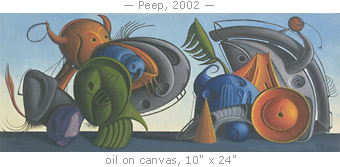 |
Valton Tyler
Born in Texas City, Texas
1944
The confluence of factors by which we, the lucky audience, may now experience the unalloyed genius of one Valton Tyler is nothing less than a small miracle.
It started with a caring brother who cajoled a meeting with Valley House Gallery owner Donald Vogel in 1970. Vogel not only saw to it that Tyler's suite of 50 etchings was completed (it was he who alerted Southern Methodist University to this prodigious talent) but also bought work and supported him for many years. The generous Lucille Teasel has from 1967 to this day (she is now 94) been a loyal friend and donor. And all along the way, Valton Tyler has attracted a series of dedicated fans both in and out of the profession, while collectors have offered profound and loyal support.

The vocabulary of form we see in this work was clearly invented by Valton Tyler. Yet for those of us familiar with Surrealist paintings of the 20s, 30s and even 40s in Europe, there appear startling analogs not only to early Dali, De Chirico and Max Ernst but also, and most importantly, to Ives Tanguy, whose work is replete with mysterious yet beautifully articulated landscapes. There is a similar sensibility operative here and, more than anything else, as James Thrall Soby wrote in a 1955 catalogue of Tanguy's one person show at the Museum of Modern Art in New York, his "life work is integral to an extraordinary degree, its discipline a strengthening rather than a constrictive force."
Valton Tyler's life work is integral too. It develops along its own path as Valton Tyler allows it to. He says, "My forms communicate with one another, they are having fun together, and I feel free and happy when I am making them, but I have to leave them and let them go their way, and I go mine." This ability to allow the work itself to direct him is another characteristic ingredient of genius — although a self-motivated inventor like Valton Tyler takes this for granted.
There is no question but that these "fictive paintings" (so titled in 1979 by Carl D. Clark) arise out of some kind of need and a profound inner truth. Mr. Tyler explains, "I look at a landscape from a distance. My technique is to blur my vision and look at everything at once." He goes on to describe how a shape appears to him — "all of a sudden I see something that's in a whole other world, the shape tells me what it wants to be; I let the shape tell what color it is... Most of the time I don't see the whole thing; I go with a gut feeling — like handwriting in a vision: how I feel inside is how I want that each space has sorta-like Henry Moore-type shapes." He has also confided, "I'm not a great admirer of my own work; I just feel like it's something I have to do — art is my therapy."

|
 |